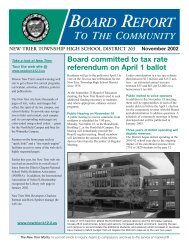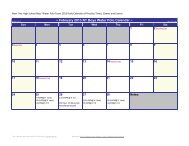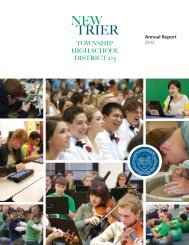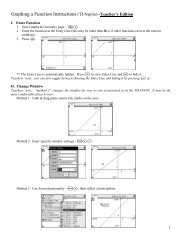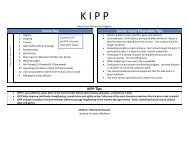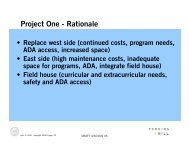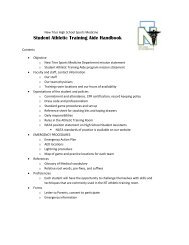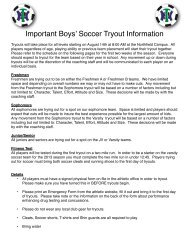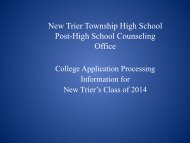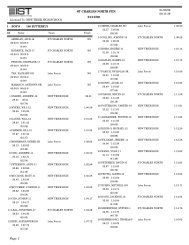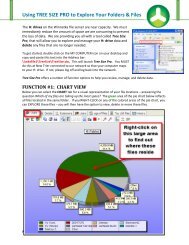HERE - New Trier Township High School
HERE - New Trier Township High School
HERE - New Trier Township High School
Create successful ePaper yourself
Turn your PDF publications into a flip-book with our unique Google optimized e-Paper software.
Lab Safety Training - RTK<br />
<strong>New</strong> <strong>Trier</strong> <strong>High</strong> <strong>School</strong><br />
Science Department<br />
2010-11
Chemical Hygiene Plan<br />
l The 2010 (revised) <strong>New</strong> <strong>Trier</strong> Science<br />
Department Chemical Hygiene & Safety<br />
Plan is the document that outlines our<br />
department safety program.<br />
l The complete CHP is accessible in the<br />
Science Shared Drive (G:) under<br />
“Chemical Hygiene & Safety.”
What To Look For…<br />
l There are Safety binders in the First<br />
Aid cabinet of each room that lists<br />
location and operation of safety<br />
equipment in that room, and<br />
emergency procedures.<br />
l Safety signage in each room. Is there<br />
something that needs replacement<br />
l Safety check routines are established<br />
and you will be asked to check on<br />
certain items each month.
What To Do…<br />
l Two lab rules that apply to the science<br />
department:<br />
– No food in laboratories. Re-sealable<br />
beverage containers are permitted only in<br />
the classroom section of the room.<br />
– Students who have no scheduled lunch<br />
periods should make arrangements with<br />
other teachers.<br />
– Friday Advisery periods are a special case:<br />
use tablecloths provided and eat only in<br />
the classroom section. Clean up all food<br />
residue prior to 1 st period.
Where Is Safety Information<br />
l We have a Safety File Cabinet in the<br />
Science Office (173 at Winnetka) that<br />
contains other safety resources. It is<br />
near the doorway between 173 and 136.<br />
l The MSDS volumes are still near the<br />
entrance to the department in 173 for<br />
quick access in case of an emergency.
Chemical Labeling<br />
l Flinn<br />
l NFPA<br />
l HMIG<br />
l MSDS
Flinn Chemical Compatibility's<br />
(see detailed example)<br />
l 10 Organic Categories<br />
l 11 Inorganic Categories<br />
l Chemicals segregated by reactivity<br />
l Acids/Bases/Flammables/Poisons stored<br />
in designated cabinets.<br />
l Nitric Acid stored separately<br />
l Volatile substances stored under fume<br />
hoods.
Important Flinn Categories<br />
l Inorganic 1 Metals<br />
l Inorganic 2 Majority of Inorganics<br />
l Inorganic 4 Hydroxides<br />
l Organic 1 Acids<br />
l Organic 2 Alcohols, Carbohydrates<br />
l Organic 9 Indicators
General Categories<br />
l Inorganic M: Boiling stones & Sand<br />
l Organic M: Agars & Culture Media<br />
l Household products stored together in<br />
each prep room as needed.
NFPA<br />
National Fire Protection Association<br />
Flammability<br />
Health<br />
Reactivity<br />
Special Notice<br />
W - Water reactive<br />
ox – Oxidizer<br />
t - Toxic<br />
c - Cancer Risk
NFPA
HMIG<br />
Hazardous Material Identification Guide<br />
l Same categories as NFPA<br />
Health Flammability Reactivity<br />
l Adds icons for Personal Protection
HMIG PPE Icons<br />
Personal Protective Equipment<br />
Vapor<br />
All respirators are stored in 179<br />
If you need something please ask! We will purchase<br />
needed equipment for your protection
Lab Safety Equipment<br />
Lab Safety Equipment<br />
l Know the location and operation of:<br />
– Safety Shower<br />
– Eye wash<br />
– Fire extinguisher(s)<br />
– Fire blanket<br />
– First aid cabinet<br />
– Emergency gas & water shutoffs (Electric is GFI)<br />
l Do you have any questions about the<br />
operations of safety equipment in your lab<br />
Ask Elaine Kollar, Mary Beth Barrett, or<br />
Nicole Hoefling.
l<br />
MSDS<br />
Material Safety Data Sheets<br />
Available in 173 and Online – Bookmark as a<br />
favorite for easy access or create a desktop<br />
shortcut.<br />
http://www.flinnsci.com/search_MSDS.asp<br />
http://www.msdssearch.com/<br />
http://msds.pdc.cornell.edu/msdssrch.asp
1<br />
23<br />
4<br />
5<br />
1 - Name<br />
2 - Hazard Rating<br />
3 - C.A.S./synonyms<br />
4 - Health Hazard<br />
5 - First Aid<br />
6 - Spill<br />
7 - PPE<br />
6<br />
7
MSDS and Health Services<br />
l Health Services requests that we have in<br />
our possession, during each laboratory<br />
experiment, paper copies of the MSDS’s.<br />
Timely medical treatment is essential,<br />
and having MSDS copies immediately<br />
available in the lab room which outline<br />
specific treatments will provide medical<br />
personnel the information they need.<br />
These copies can be kept in your folder or<br />
lesson plans so they can be retrieved<br />
immediately upon an accident occurring.
Chemical Inventory & Storage
Organization of Chemicals<br />
• The Flinn Scientific system of labeling<br />
chemicals and shelving is used<br />
throughout the department.<br />
• The system separates chemicals into<br />
groups (I#1, I#2, O#1, etc.) that do not<br />
react with each other. Groups that do<br />
react with each other are then physically<br />
separated in the storage rooms.
Where’s s Waldo<br />
l<br />
l<br />
l<br />
l<br />
Refer to the Flinn catalog for the group<br />
designation.<br />
Familiarize yourself with the storerooms.<br />
Ask for help in locating chemicals.<br />
A current inventory is on our Science Shared<br />
drive (G drive) under “Chemical Hygiene &<br />
Safety.”
Designated Chemical Storage<br />
Winnetka<br />
l 164a Inorganics<br />
l 161a Organics and Indicators; Inorganics for use by teachers<br />
in adjacent rooms<br />
l Household chemicals – stored in most prep rooms<br />
l Basement - Liquid Overstock<br />
l All storage rooms and labs may also contain commonly used<br />
chemicals and chemicals in lab setups<br />
l Two locked poison cabinets in 161a & 164a<br />
l Radioactive samples are in a file cabinet in 164a. Please<br />
keep radioactive samples in the bottom drawer, and<br />
detectors in the top drawer.<br />
Northfield<br />
l 2 central storerooms on the 2 nd and 3 rd floors
Extremely Hazardous Materials<br />
While all chemicals have the potential to be<br />
hazardous, the following categories of<br />
chemicals are considered extremely hazardous.<br />
No materials should be used unless the<br />
educational value outweighs the risk. Always<br />
overestimate the dangers of chemicals.<br />
l Explosives - e.g., Ethyl Ether<br />
l Poisons - e.g., Bromine<br />
l Carcinogens - e.g., Cadmium & Cd salts<br />
l Caustics - e.g., Concentrated Acids<br />
l Flammables - e.g., Sodium (metal)<br />
l Irritants - e.g., Butyric Acid
Chemical Disposal<br />
l Check Flinn Catalog for appropriate<br />
disposal if a substance cannot be<br />
neutralized.<br />
l Collect hazardous waste and label with<br />
“Discard” sheet: chemical names, your<br />
name, and date – Ask for information<br />
and/or disposal help.<br />
l Waste is removed usually every other<br />
year with PPS and Art Department waste
Summary<br />
l Read MSDS before handling chemicals.<br />
l Have MSDS in lab<br />
l Teach students how to read labels.<br />
l Learn Flinn storage.
Equipment Use & Safety<br />
l Maintain equipment by inspecting<br />
cords, moving parts, etc.<br />
l Identify with your name and tag broken<br />
equipment<br />
l Notify Science Lab Supervisor or PPS<br />
for repair.
Fire Safety<br />
l Think safety for people first!!!<br />
l Evacuate the area<br />
l Notify the fire department (Dial 911 or<br />
PPS or pull box if necessary)<br />
l Small fires: use fire extinguishers<br />
l On people: use fire blankets
Fire Extinguishers<br />
l<br />
l<br />
l<br />
Our labs contain ABC Dry Chemical<br />
extinguishers.<br />
ABC or Multi-Purpose extinguisher utilize a<br />
specially fluidized and siliconized mono<br />
ammonium phosphate dry chemical.<br />
– It chemically insulates Class A fires by melting at<br />
approximately 350°F and coats the surface to which<br />
it is applied.<br />
– It smothers and breaks the chain reaction of Class B<br />
fires and will not conduct electricity back to the<br />
operator.<br />
If you are working with burning metals, a Class<br />
D (164a) or bucket of sand should be in your<br />
lab.
Using a Fire Extinguisher<br />
l Remember PASS<br />
–Pull the pin<br />
–Aim at the base of the fire<br />
–Squeeze the lever slowly<br />
–Sweep from side to side
How to Use a Fire Extinguisher<br />
Pull the pin…<br />
This will allow<br />
you to<br />
discharge the<br />
extinguisher<br />
Environmental Health & Safety Dept.
How to Use a Fire Extinguisher<br />
Aim at the base of the fire…<br />
Hit the fuel.<br />
If you aim at<br />
the flames...<br />
… the extinguishing agent will fly right<br />
through and do no good.<br />
Environmental Health & Safety Dept.
How to Use a Fire Extinguisher<br />
Squeeze the top handle…<br />
This depresses a<br />
button that<br />
releases the<br />
pressurized<br />
extinguishing<br />
agent.<br />
Environmental Health & Safety Dept.
How to Use a Fire Extinguisher<br />
Sweep from side to side…<br />
.. until the fire is<br />
completely out.<br />
Start using the extinguisher<br />
from a safe distance away,<br />
then slowly move forward.<br />
Once the fire is out, keep an eye on the area in case<br />
it re-ignites.<br />
Environmental Health & Safety Dept.
First Aid<br />
l You are responsible to provide aid to<br />
the level of your training. For example,<br />
if you are CPR certified you are<br />
expected to use your talents.<br />
l If there is blood, be sure to contact the<br />
nurse and/or send the student to<br />
Health Services. Use the phone in the<br />
lab.<br />
l First aid cabinets are in all labs – check<br />
for supplies regularly. (e.g., the Quik-<br />
Chlor Kit and Band aids)
Reminders<br />
l You are a science educator and<br />
professional who is responsible to look<br />
up and determine safety risks for<br />
yourself and your students.<br />
l If you do not know something, ask<br />
questions and research answers
Sign Off<br />
l By completing this process online you<br />
will sign off as having completed this<br />
year’s safety training<br />
l Throughout the year you will receive<br />
safety information during department<br />
meetings that you are expected to read.<br />
If you have any questions or concerns<br />
please talk to Elaine, Mary Beth, Nicole,<br />
Robyn, or Gerry.



